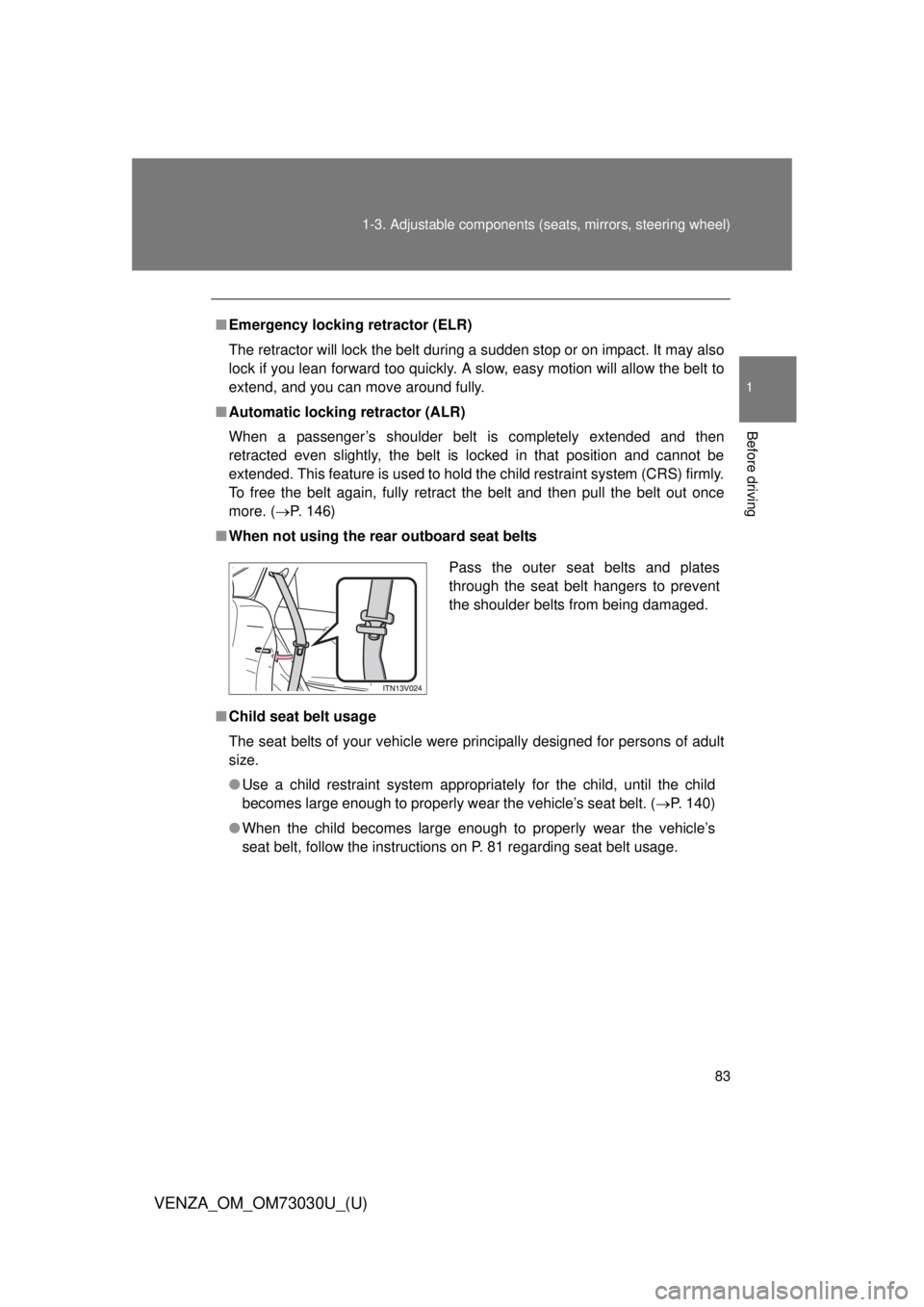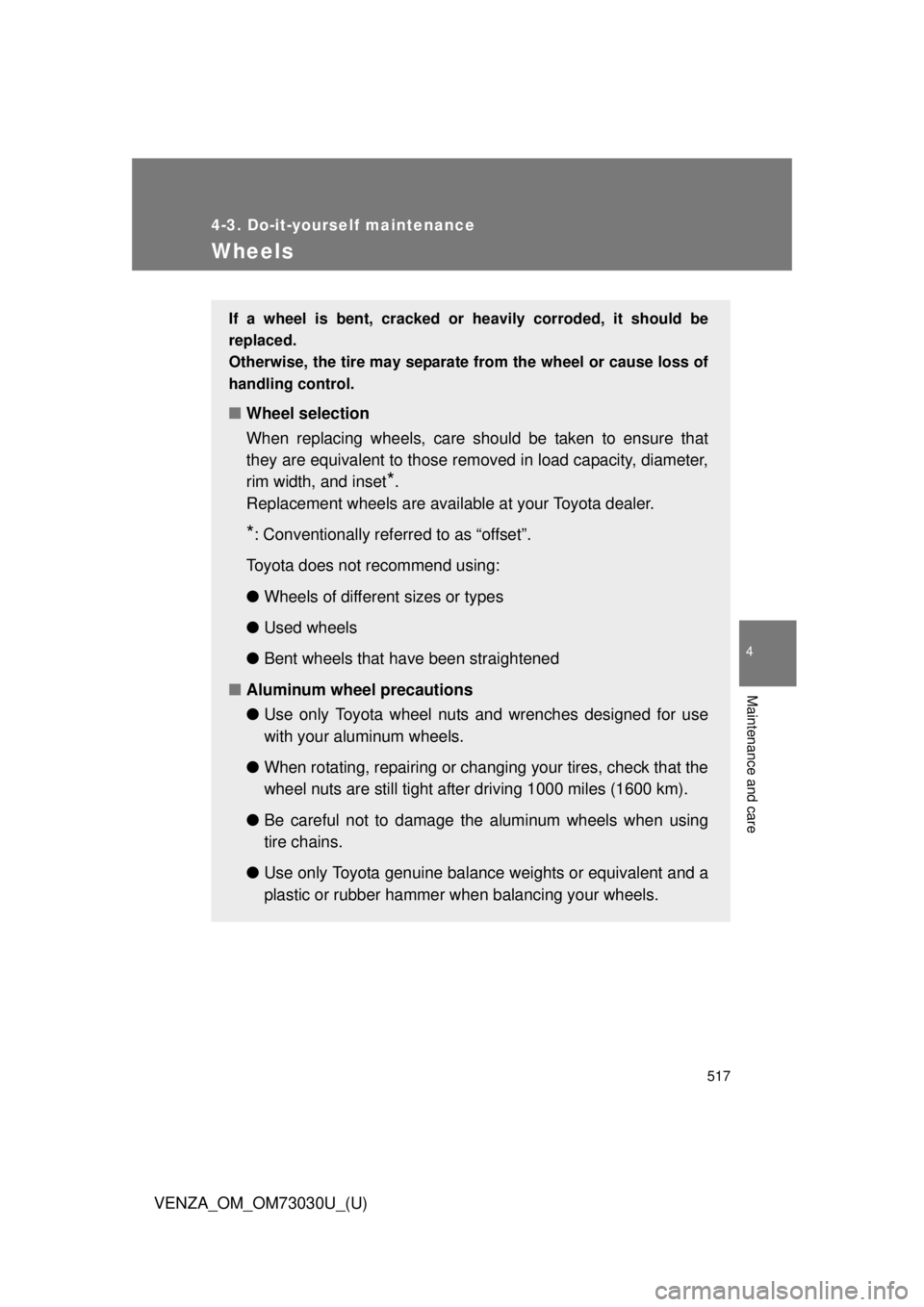Page 83 of 688

831-3. Adjustable components (s eats, mirrors, steering wheel)
1
Before driving
VENZA_OM_OM73030U_(U) ■ Emergency locking retractor (ELR)
The retractor will lock the belt during a sudden stop or on impact. It may also
lock if you lean forward too quickly. A slow, easy motion will allow the belt to
extend, and you can move around fully.
■ Automatic locking retractor (ALR)
When a passenger’s shoulder belt is completely extended and then
retracted even slightly, the belt is locked in that position and cannot be
extended. This feature is used to hold the child restraint system (CRS) firmly.
To free the belt again, fully retract the belt and then pull the belt out once
more. ( P. 146)
■ When not using the rear outboard seat belts
■ Child seat belt usage
The seat belts of your vehicle were principally designed for persons of adult
size.
● Use a child restraint system appropriately for the child, until the child
becomes large enough to properly wear the vehicle’s seat belt. ( P. 140)
● When the child becomes large enough to properly wear the vehicle’s
seat belt, follow the instructions on P. 81 regarding seat belt usage. Pass the outer seat belts and plates
through the seat belt hangers to prevent
the shoulder belts from being damaged.
Page 261 of 688

2612-4. Using other driving systems
2
When driving
VENZA_OM_OM73030U_(U) CAUTION■ When TRAC and VSC are off
Be especially careful and drive at a speed appropriate to the road condi-
tions. As there are systems to help ensure vehicle stability and driving force,
do not turn off TRAC and VSC unless necessary.
■ When the VSC is activated
The slip indicator light flashes. Always drive carefully.
Reckless driving may cause an accident. Exercise particular care when the
indicator light flashes.
■ Replacing tires
Make sure that all tires are of the same size, brand, tread pattern and total
load capacity. In addition, make sure that the tires are inflated to the speci-
fied tire pressure level.
The ABS and VSC will not function correctly if different tires are fitted on the
vehicle.
Contact your Toyota dealer for further information when replacing tires or
wheels.
■ Handling of tires and suspension
Using tires with any kind of problem or modifying the suspension will affect
the driving assist systems, and may cause the system to malfunction.
■ Active Torque Control 4WD system
● The AWD system of this vehicle is intended to ensure driving stability on
normal roads. It is not designed for use in demanding situations such as
rally driving.
● Take care when driving on slippery road surfaces.
Page 279 of 688

2792-5. Driving information
2
When driving
VENZA_OM_OM73030U_(U) CAUTION■ Driving with snow tires
Observe the following precautions to reduce the risk of accidents.
Failing to do so may result in a loss of vehicle control and cause death or
serious injury.
● Use tires of the size specified for your vehicle.
● Maintain the recommended level of tire inflation pressure.
● Do not drive in excess of 75 mph (120 km/h), regardless of the type of
snow tires being used.
● Snow tires should be installed on all wheels.
■ Driving with tire chains
Observe the following precautions to reduce the risk of accidents.
Failing to do so may result in the vehicle being unable to be driven safely,
and may cause death or serious injury.
● Do not drive in excess of the speed limit specified for the tire chains being
used, or 30 mph (50 km/h), whichever is lower.
● Avoid driving on bumpy road surfaces or over potholes.
● Avoid sudden acceleration, abrupt steering, sudden braking and shifting
operations that cause sudden engine braking.
● Slow down sufficiently before entering a curve to ensure that vehicle con-
trol is maintained.
Page 508 of 688

5084-3. Do-it-yourself maintenance
VENZA_OM_OM73030U_(U) ■
When to replace your vehicle’s tires
Tires should be replaced if: ●
The treadwear indicators are showing on a tire.●
You have tire damage such as cuts, splits, cracks deep enough to
expose the fabric or bulges indicating internal damage●
A tire goes flat repeatedly or c annot be properly repaired due to the
size or location of a cut or other damage
If you are not sure, consult with your Toyota dealer.■
Replacing tires and wheels
If the ID code of the tire pressure warning valve and transmitter is not
registered, the tire pre ssure warning system will not work properly. After
driving for about 20 minutes, the ti re pressure warning light comes on
after blinking for 1 minute to indicate a system malfunction.■
Tire life
Any tire over 6 years old must be checked by a qualified technician even
if they have seldom or never been used or damage is not obvious.■
Routine tire inflation pressure checks
The tire pressure warning system doe s not replace routine tire inflation
pressure checks. Make sure to check tire inflation pressure as part of
your routine of daily vehicle checks.■
If the tread wears down below 0.16 in. (4 mm) on snow tires
The effectiveness of snow tires is lost.
■
Maximum load of tire
Check that the number given by di viding the maximum load by 1.10 of
the replacement tire is greater than 1/2 of the Gross Axle Weight Ratings
(GAWR) of either the front axle or the rear axle, whichever is greater.
For the GAWR, see the Certification
Label. For the maximum load of the
tire, see the load limit at maximum cold
tire inflation pressure mentioned on the
sidewall of the tire. ( P. 630)
Page 509 of 688

5094-3. Do-it-yourself maintenance
4
Maintenance and care
VENZA_OM_OM73030U_(U) ■
Tire types
1 Summer tires
Summer tires are high-speed performance tires best suited to highway
driving under dry conditions. Since summer tires do not have the same
traction performance as snow tire s, summer tires are inadequate for
driving on snow-covered or icy roads. For driving on snow-covered
roads or icy roads, the use of snow tires is recommended. When
installing snow tires, be sure to replace all four tires.
2 All season tires
All season tires are designed to provide better traction in snow and to
be adequate for driving in most winter conditions, as well as for use
year round. All season tires, however, do not have adequate traction
performance compared with snow tires in heavy or loose snow. Also,
all season tires fall short in acceleration and handling performance
compared with summer tires in highway driving.
3Snow tires
For driving on snow-covered roads or icy roads, we recommend using
snow tires. If you need snow tires, select tires of the same size, con-
struction and load capacity as the or iginally installed tires. Since your
vehicle has radial tires as original equipment, make sure your snow
tires also have radial construction. Do not install studded tires without
first checking local regulations for possible restriction. Snow tires
should be installed on all wheels. ( P. 276)
Page 517 of 688

5174-3. Do-it-yourself maintenance
4
Maintenance and care
VENZA_OM_OM73030U_(U) Wheels If a wheel is bent, cracked or heavily corroded, it should be
replaced.
Otherwise, the tire may separate from the wheel or cause loss of
handling control.
■ Wheel selection
When replacing wheels, care should be taken to ensure that
they are equivalent to those removed in load capacity, diameter,
rim width, and inset
* .
Replacement wheels are available at your Toyota dealer.
* : Conventionally referred to as “offset”.
Toyota does not recommend using:
● Wheels of different sizes or types
● Used wheels
● Bent wheels that have been straightened
■ Aluminum wheel precautions
● Use only Toyota wheel nuts and wrenches designed for use
with your aluminum wheels.
● When rotating, repairing or changing your tires, check that the
wheel nuts are still tight after driving 1000 miles (1600 km).
● Be careful not to damage the aluminum wheels when using
tire chains.
● Use only Toyota genuine balance weights or equivalent and a
plastic or rubber hammer when balancing your wheels.
Page 518 of 688
5184-3. Do-it-yourself maintenance
VENZA_OM_OM73030U_(U) ■
When replacing wheels
The wheels of your Toyota are equipped with tire pressure warning
valves and transmitters that allow the tire pressure warning system to
provide advanced warning in the event of a loss in tire inflation pressure.
Whenever wheels are replaced, the tire pressure warning valves and
transmitters must be installed. ( P. 507)
CAUTION■
When replacing wheels ●
Do not use wheels that are a different size from those recommended in
the Owner’s Manual, as this may re sult in loss of handling control.●
Never use an inner tube in a leaking wheel which is designed for a
tubeless tire. Doing so may result in an accident, causing death or seri-
ous injury.
Page 622 of 688
6226-1. Specifications
VENZA_OM_OM73030U_(U) Tires and wheels
Type A Tire size P245/50R20 102H
Tire inflation pressure
(Recommended cold tire
inflation pressure) Driving under normal conditions
Front tires:
32 psi (220 kPa, 2.2 kgf/cm 2
or bar)
Rear tires:
32 psi (220 kPa, 2.2 kgf/cm 2
or bar)
Driving at high speeds above 99 mph
(160 km/h) (in countries where such
speeds are permitted by law)
Add 3 psi (20 kPa, 0.2 kgf/cm 2
or bar)
to the front tires and rear tires. Never
exceed the maximum cold tire inflation
pressure indicated on the tire sidewall.
Wheel size 20 7 1/2 J
Wheel nut torque 76 ft•lbf (103 N•m, 10.5 kgf•m)